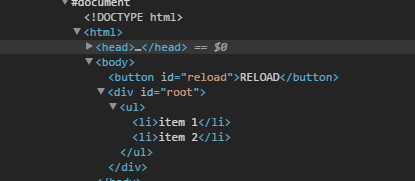Rumah >hujung hadapan web >tutorial js >如何编写自己的虚拟DOM?方法介绍
如何编写自己的虚拟DOM?方法介绍
- 青灯夜游ke hadapan
- 2020-10-29 17:30:212832semak imbas

要构建自己的虚拟DOM,需要知道两件事。你甚至不需要深入 React 的源代码或者深入任何其他虚拟DOM实现的源代码,因为它们是如此庞大和复杂——但实际上,虚拟DOM的主要部分只需不到50行代码。
有两个概念:
- Virtual DOM 是真实DOM的映射
- 当虚拟 DOM 树中的某些节点改变时,会得到一个新的虚拟树。算法对这两棵树(新树和旧树)进行比较,找出差异,然后只需要在真实的 DOM 上做出相应的改变。
用JS对象模拟DOM树
首先,我们需要以某种方式将 DOM 树存储在内存中。可以使用普通的 JS 对象来做。假设我们有这样一棵树:
<ul class=”list”> <li>item 1</li> <li>item 2</li> </ul>
看起来很简单,对吧? 如何用JS对象来表示呢?
{ type: ‘ul’, props: { ‘class’: ‘list’ }, children: [
{ type: ‘li’, props: {}, children: [‘item 1’] },
{ type: ‘li’, props: {}, children: [‘item 2’] }
] }
这里有两件事需要注意:
- 用如下对象表示DOM元素
{ type: ‘…’, props: { … }, children: [ … ] }
- 用普通 JS 字符串表示 DOM 文本节点
但是用这种方式表示内容很多的 Dom 树是相当困难的。这里来写一个辅助函数,这样更容易理解:
function h(type, props, …children) {
return { type, props, children };
}
用这个方法重新整理一开始代码:
h(‘ul’, { ‘class’: ‘list’ },
h(‘li’, {}, ‘item 1’),
h(‘li’, {}, ‘item 2’),
);
这样看起来简洁多了,还可以更进一步。这里使用 JSX,如下:
<ul className=”list”> <li>item 1</li> <li>item 2</li> </ul>
编译成:
React.createElement(‘ul’, { className: ‘list’ },
React.createElement(‘li’, {}, ‘item 1’),
React.createElement(‘li’, {}, ‘item 2’),
);
是不是看起来有点熟悉?如果能够用我们刚定义的 h(...) 函数代替 React.createElement(…),那么我们也能使用JSX 语法。其实,只需要在源文件头部加上这么一句注释:
/** @jsx h */ <ul className=”list”> <li>item 1</li> <li>item 2</li> </ul>
它实际上告诉 Babel ' 嘿,小老弟帮我编译 JSX 语法,用 h(...) 函数代替 React.createElement(…),然后 Babel 就开始编译。'
综上所述,我们将DOM写成这样:
/** @jsx h */ const a = ( <ul className=”list”> <li>item 1</li> <li>item 2</li> </ul> );
Babel 会帮我们编译成这样的代码:
const a = (
h(‘ul’, { className: ‘list’ },
h(‘li’, {}, ‘item 1’),
h(‘li’, {}, ‘item 2’),
);
);
当函数 “h” 执行时,它将返回普通JS对象-即我们的虚拟DOM:
const a = (
{ type: ‘ul’, props: { className: ‘list’ }, children: [
{ type: ‘li’, props: {}, children: [‘item 1’] },
{ type: ‘li’, props: {}, children: [‘item 2’] }
] }
);
从Virtual DOM 映射到真实 DOM
好了,现在我们有了 DOM 树,用普通的 JS 对象表示,还有我们自己的结构。这很酷,但我们需要从它创建一个真正的DOM。
首先让我们做一些假设并声明一些术语:
- 使用以'
$'开头的变量表示真正的DOM节点(元素,文本节点),因此 $parent 将会是一个真实的DOM元素 - 虚拟 DOM 使用名为
node的变量表示
* 就像在 React 中一样,只能有一个根节点——所有其他节点都在其中
那么,来编写一个函数 createElement(…),它将获取一个虚拟 DOM 节点并返回一个真实的 DOM 节点。这里先不考虑 props 和 children 属性:
function createElement(node) {
if (typeof node === ‘string’) {
return document.createTextNode(node);
}
return document.createElement(node.type);
}
上述方法我也可以创建有两种节点分别是文本节点和 Dom 元素节点,它们是类型为的 JS 对象:
{ type: ‘…’, props: { … }, children: [ … ] }
因此,可以在函数 createElement 传入虚拟文本节点和虚拟元素节点——这是可行的。
现在让我们考虑子节点——它们中的每一个都是文本节点或元素。所以它们也可以用 createElement(…) 函数创建。是的,这就像递归一样,所以我们可以为每个元素的子元素调用 createElement(…),然后使用 appendChild() 添加到我们的元素中:
function createElement(node) {
if (typeof node === ‘string’) {
return document.createTextNode(node);
}
const $el = document.createElement(node.type);
node.children
.map(createElement)
.forEach($el.appendChild.bind($el));
return $el;
}
哇,看起来不错。先把节点 props 属性放到一边。待会再谈。我们不需要它们来理解虚拟DOM的基本概念,因为它们会增加复杂性。
完整代码如下:
/** @jsx h */
function h(type, props, ...children) {
return { type, props, children };
}
function createElement(node) {
if (typeof node === 'string') {
return document.createTextNode(node);
}
const $el = document.createElement(node.type);
node.children
.map(createElement)
.forEach($el.appendChild.bind($el));
return $el;
}
const a = (
<ul class="list">
<li>item 1</li>
<li>item 2</li>
</ul>
);
const $root = document.getElementById('root');
$root.appendChild(createElement(a));
比较两棵虚拟DOM树的差异
现在我们可以将虚拟 DOM 转换为真实的 DOM,这就需要考虑比较两棵 DOM 树的差异。基本的,我们需要一个算法来比较新的树和旧的树,它能够让我们知道什么地方改变了,然后相应的去改变真实的 DOM。
怎么比较 DOM 树?需要处理下面的情况:
- 添加新节点,使用 appendChild(…) 方法添加节点

- 移除老节点,使用 removeChild(…) 方法移除老的节点

- 节点的替换,使用 replaceChild(…) 方法

如果节点相同的——就需要需要深度比较子节点

编写一个名为 updateElement(…) 的函数,它接受三个参数—— $parent、newNode 和 oldNode,其中 $parent 是虚拟节点的一个实际 DOM 元素的父元素。现在来看看如何处理上面描述的所有情况。
添加新节点
function updateElement($parent, newNode, oldNode) {
if (!oldNode) {
$parent.appendChild(
createElement(newNode)
);
}
}
移除老节点
这里遇到了一个问题——如果在新虚拟树的当前位置没有节点——我们应该从实际的 DOM 中删除它—— 这要如何做呢?
如果我们已知父元素(通过参数传递),我们就能调用 $parent.removeChild(…) 方法把变化映射到真实的 DOM 上。但前提是我们得知道我们的节点在父元素上的索引,我们才能通过 $parent.childNodes[index] 得到该节点的引用。
好的,让我们假设这个索引将被传递给 updateElement 函数(它确实会被传递——稍后将看到)。代码如下:
function updateElement($parent, newNode, oldNode, index = 0) {
if (!oldNode) {
$parent.appendChild(
createElement(newNode)
);
} else if (!newNode) {
$parent.removeChild(
$parent.childNodes[index]
);
}
}
节点的替换
首先,需要编写一个函数来比较两个节点(旧节点和新节点),并告诉节点是否真的发生了变化。还有需要考虑这个节点可以是元素或是文本节点:
function changed(node1, node2) {
return typeof node1 !== typeof node2 ||
typeof node1 === ‘string’ && node1 !== node2 ||
node1.type !== node2.type
}
现在,当前的节点有了 index 属性,就可以很简单的用新节点替换它:
function updateElement($parent, newNode, oldNode, index = 0) {
if (!oldNode) {
$parent.appendChild(
createElement(newNode)
);
} else if (!newNode) {
$parent.removeChild(
$parent.childNodes[index]
);
} else if (changed(newNode, oldNode)) {
$parent.replaceChild(
createElement(newNode),
$parent.childNodes[index]
);
}
}
比较子节点
最后,但并非最不重要的是——我们应该遍历这两个节点的每一个子节点并比较它们——实际上为每个节点调用updateElement(…)方法,同样需要用到递归。
- 当节点是 DOM 元素时我们才需要比较( 文本节点没有子节点 )
- 我们需要传递当前的节点的引用作为父节点
- 我们应该一个一个的比较所有的子节点,即使它是
undefined也没有关系,我们的函数也会正确处理它。 - 最后是 index,它是子数组中子节点的 index
function updateElement($parent, newNode, oldNode, index = 0) {
if (!oldNode) {
$parent.appendChild(
createElement(newNode)
);
} else if (!newNode) {
$parent.removeChild(
$parent.childNodes[index]
);
} else if (changed(newNode, oldNode)) {
$parent.replaceChild(
createElement(newNode),
$parent.childNodes[index]
);
} else if (newNode.type) {
const newLength = newNode.children.length;
const oldLength = oldNode.children.length;
for (let i = 0; i < newLength || i < oldLength; i++) {
updateElement(
$parent.childNodes[index],
newNode.children[i],
oldNode.children[i],
i
);
}
}
}完整的代码
Babel+JSX
/* @jsx h /
function h(type, props, ...children) {
return { type, props, children };
}
function createElement(node) {
if (typeof node === 'string') {
return document.createTextNode(node);
}
const $el = document.createElement(node.type);
node.children
.map(createElement)
.forEach($el.appendChild.bind($el));
return $el;
}
function changed(node1, node2) {
return typeof node1 !== typeof node2 ||
typeof node1 === 'string' && node1 !== node2 ||
node1.type !== node2.type
}
function updateElement($parent, newNode, oldNode, index = 0) {
if (!oldNode) {
$parent.appendChild(
createElement(newNode)
);
} else if (!newNode) {
$parent.removeChild(
$parent.childNodes[index]
);
} else if (changed(newNode, oldNode)) {
$parent.replaceChild(
createElement(newNode),
$parent.childNodes[index]
);
} else if (newNode.type) {
const newLength = newNode.children.length;
const oldLength = oldNode.children.length;
for (let i = 0; i < newLength || i < oldLength; i++) {
updateElement(
$parent.childNodes[index],
newNode.children[i],
oldNode.children[i],
i
);
}
}
}
// ---------------------------------------------------------------------
const a = (
<ul>
<li>item 1</li>
<li>item 2</li>
</ul>
);
const b = (
<ul>
<li>item 1</li>
<li>hello!</li>
</ul>
);
const $root = document.getElementById('root');
const $reload = document.getElementById('reload');
updateElement($root, a);
$reload.addEventListener('click', () => {
updateElement($root, b, a);
});
HTML
<button id="reload">RELOAD</button> <p id="root"></p>
CSS
#root {
border: 1px solid black;
padding: 10px;
margin: 30px 0 0 0;
}
打开开发者工具,并观察当按下“Reload”按钮时应用的更改。

总结
现在我们已经编写了虚拟 DOM 实现及了解它的工作原理。作者希望,在阅读了本文之后,对理解虚拟 DOM 如何工作的基本概念以及在幕后如何进行响应有一定的了解。
然而,这里有一些东西没有突出显示(将在以后的文章中介绍它们):
- 设置元素属性(props)并进行 diffing/updating
- 处理事件——向元素中添加事件监听
- 让虚拟 DOM 与组件一起工作,比如React
- 获取对实际DOM节点的引用
- 使用带有库的虚拟 DOM,这些库可以直接改变真实的 DOM,比如 jQuery 及其插件
原文地址:https://medium.com/@deathmood/how-to-write-your-own-virtual-dom-ee74acc13060
作者:deathmood
为了保证的可读性,本文采用意译而非直译。
更多编程相关知识,请访问:编程入门!!
Atas ialah kandungan terperinci 如何编写自己的虚拟DOM?方法介绍. Untuk maklumat lanjut, sila ikut artikel berkaitan lain di laman web China PHP!

